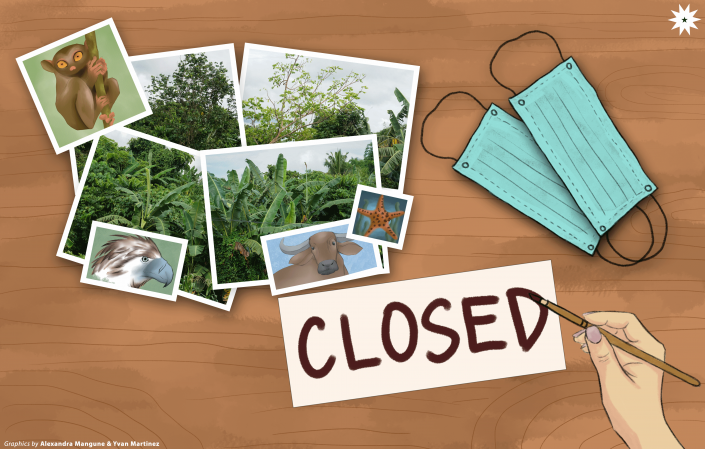A haven of biodiversity, the Philippines is home to 645 endangered and threatened species—like the Philippine eagle or the Mindoro dwarf buffalo, whose population numbers are dwindling rapidly—due to various factors such as habitat loss and human exploitation. Wildlife sanctuaries are vital in carrying out animal conservation and preservation efforts. These serve as a refuge to safeguard animals against threats such as poaching, hunting, and abuse.
Animals in these sanctuaries have a tendency to be agitated in the presence of humans, especially for those who have not yet adjusted to their new surroundings. With the COVID-19 pandemic and lockdown measures, the animals were given a respite from the noise and ecological disturbances normally driven by human activity. Joannie Mary Cabillo—program manager of the Philippine Tarsier Foundation (PTF), a non-governmental organization for the conservation of tarsiers—also observed the change, “The animals love the peace of the lockdown.”
However, with this limited human movement due to the pandemic, funds and resources have dwindled. Now, animal shelters must find ways to continue their services for the animals under their care, especially since these creatures require special attention and protection.
Behind closed doors
As the pandemic escalated, sanctuaries were temporarily closed from the general public as a protective measure against zoonotic leakage, or the possible transmission of disease between animals and humans, given the uncertainty over mechanisms of spread of the coronavirus. However, some sanctuaries still try to accommodate more animals albeit at a lower rate and with precautionary protocols.
“All animal [species], turned over to the center, exotic or indigenous, undergo the same protocol,” notes Anson Tagtag, chief of the Wildlife Conservation Section of the Department of Environment and Natural Resources (DENR). When animals are brought to shelters by concerned citizens or groups, veterinarians first conduct a health assessment. Afterward, the received animals undergo strict quarantine to assess the possibility of an infection or disease. They are isolated in a designated area for at least 30 days before they can be released to the wildlife sanctuaries.
In addition, the health of sanctuary staff and volunteers must also be prioritized since they interact with other people and different species of animals. Once a staff member does not feel well, they must stay at home to avoid the risk of spreading any form of disease.

The caretaker’s dilemma
However, the closure of sanctuaries from the general public brought significant cuts to their finances; private wildlife sanctuaries like PTF face bankruptcy due to lack of resources, as the majority of their funds would be dependent on tourism or visits from the public. “The foundation is spending for all the expenses of the staff labor for maintenance and protection, but no cash flow has [come] in,” Cabillo explains.
These caretakers thus face a considerable dilemma, since they cannot simply leave animals by themselves as they have come to depend on humans for food, habitat, and protection. Additionally, monitoring the animals is important to prevent them from reproducing—unless they are part of a conservation and breeding program—as many shelters barely have enough space for those they currently protect.
With no definitive end in sight for the pandemic, Cabillo and the organization are waiting for protocols from the government to guide their next steps. Nevertheless, she assures that PTF will continue to operate for the time being. “The best we can do in this time of pandemic is to do our [mandated] role and pray to survive financially even for the year,” she shares.
Taking the bull by the horns
As caretakers press on running sanctuaries, they will continue protecting wildlife through strict regulations and programs such as by strengthening their wildlife law enforcement to avoid illegal wildlife trade and endangering vulnerable species.
Tagtag also mentions different legislations currently in place like the National Integrated Protected Areas System Act of 1992, which provides a “broad measure to protect wildlife resources in their natural habitat. Composed of the country’s terrestrial and coastal marine ecosystems, there are 244 protected areas—regions specifically for conserving nature and biodiversity whose natural ecosystems are maintained by designated bodies and prevented from being disrupted by human disturbances.
“The pandemic [is] an opportunity to reiterate the DENR’s advocacy on the conservation of wildlife especially in relation to avoidance of zoonotic diseases,” says Tagtag. This conservation agenda involves protecting the remaining wildlife habitats; restoring damaged ecosystems; promoting various area-based conservation measures such as designating more protected areas; and strictly complying with wildlife trade regulations including strict health protocols to avoid “the potential transfer of infectious diseases and pests.”
Sanctuaries contribute greatly to these biodiversity conservation efforts, but struggling with depleting resources, these centers themselves are in dire need of protection. As, without a refuge, where would abandoned and threatened animals go?
